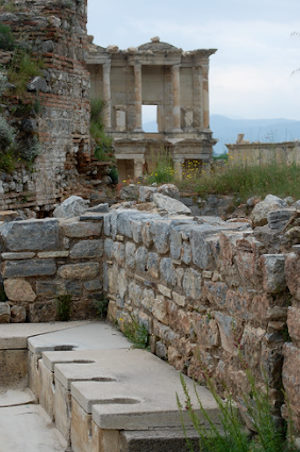Ancient Toilets of Ephesus
In the ancient city of Ephesus, it is possible to come across ruins related to every aspect of daily life. Among these ruins are the latrines, one of the most interesting and important structures of the Roman and Greek world.
Latrines are, simply put, the toilets of the ancient world. However, these structures were not only used to fulfill physiological needs, they were also a critical part of social interactions and community life.
Ephesus is famous for many world-known buildings like Celsus library and grand theater, but if you ask me, this is what most people will remember after visiting Ephesus Ancient City in Turkey. Ephesus Latrines were public toilets which very much resembled our modern toilets today.
In ancient Greek Ephesus, latrines were usually simple structures located outside houses or near public buildings. However, in Roman Ephesus, latrines became more complex and sophisticated and were integrated into public buildings, public baths and public spaces such as marketplaces. The Roman latrines found in Ephesus today were built integrated into the Ephesus Bath Buildings.
How did Ephesus latrines work?
The toilet facility was mainly used by men. It was completely free of charge, since people were leaving their ammonia-rich urine behind. The latrine’s channels underneath were not connected to the city’s main sewage system. When a man urinated, his urine was kept in the channel. A slave used to shovel all the urine and other material collected into the channel, and he used to carry it to a facility where ammonia was distilled out of the mix. Ammonia was used in clothes and home hygiene. It might sound disgusting, but you should understand that ammonia is a strong cleaner even today.
Ephesus Latrines were a clean and modern facility for its time
Latrines used to have a pool in the middle, which supplied fresh and clean water for the people using the facility. People were dipping sponges into this pool and cleaning their private parts in a manner that is close to using toilet paper today. Sponges were cleaned and reused. Even today, natural sponge can be easily found in the Mediterranean part of the world. Toilets were intentionally built next to bathhouses. People could stop by the toilets before they head to the bathhouse, which is located on the north face of the latrines.
Fast facts about Ephesus Latrines
- Ephesian Latrines were used by man and woman but in different times
- Ephesus Latrines were free of charge
- Seats of the latrines were preheated by slaves
- Latrines were fully covered with a roof
Get Ephesus Tour Guide
The Latrines of Ephesus are a unique group of structures representing the advanced understanding of the Roman period in the fields of engineering, urbanism and social life. These structures, which are of great importance in terms of both hygiene and social interaction, were a factor that improved the quality of life of people in antiquity. For anyone visiting Ephesus, seeing these magnificent structures up close and understanding their historical context opens a window into the civilization of the ancient world.
I hope one day you will have the most memorable photo in the ancient toilets of Ephesus, Turkey. You can write to me if you have any questions, or you can book a professional tour guide to Ephesus to see the Ancient Toilets of Ephesus, aka Latrines yourself. See you soon, Hasan Gülday.
